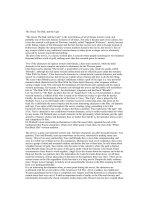proclaim the good the bad and the ugly
Bạn đang xem bản rút gọn của tài liệu. Xem và tải ngay bản đầy đủ của tài liệu tại đây (1.72 MB, 2 trang )
Can you tell the difference between
the good, the bad and the ugly?
PROCLAIM® can.
Benefits of PROCLAIM
Naturally derived
Fast, robust performance
Developed from a soil micro-organism,
Streptomyces avermitilis
Active on all feeding larval stages
Reliable performance
Moves through the leaf to protect the underside
Performs under pressure against
Lightbrown Apple Moth and Grapevine Moth
Quick absorption
Flexible application
Can be applied up to pre-bunch closure
(E&L 31) growth stage
Ovi-larvicidal activity
Larvae can be controlled as they hatch and
before they feed on the leaf
Translaminar movement
Any remaining residue on the outside of the leaf is
quickly degraded
Low disruption of beneficials
Ideal for Integrated Pest Management programs
Botrytis control
Applied with SWITCH® at pre bunch closure for
premium integrated control
cont. overleaf
Independent research confirms PROCLAIM is soft on
key beneficial insects
There are several species of beneficial insects that are of
Acute toxicity (direct spray) bioassay results
interest to grape growers in terms of managing some key
Table 1. Mortality (%) of species exposed to direct sprays of insecticides.
pests in vineyards.
Mallada signatus is one of the most common Green
Species
Control
(water)
Lacewings which are active in grapevines from late spring
to autumn. Green Lacewings are considered as one of the
Insecticide
PPROCLAIM
(44 g/kg
emamectin)
Spinosad
(120 g/L)
Indoxacarb
(400 g/kg)
Hippodamia variegata
7.5
7.2
17.3
80.6*
Stethorus sp
2.5
11.9
100*
80.8*
Lacewings will attack and eat almost any small insects or
Mallada signatus
3.1
5.9
9.4
69.5*
eggs, the juveniles prey on aphids, mites, scales, mealybugs,
Trichogramma carverae (adults)
8.7
100*
100*
90.8*
small caterpillars and moth eggs.
Trichogramma carverae (juveniles)
6.7
9.4
93.5*
3.5
most important wide ranging predators in grapevines. Green
Trichogramma carverae or Trichogramma wasp are
minute wasps which lay their eggs into the eggs of various
lepidoptera pests, the favoured host eggs of Trichogramma
carverae in grapevines are those of LBAM and Heliothis
Helicoperva. Once the wasp eggs have hatched they begin
to feed on the developing moth eggs.
* Mortality figures followed by an asterix (*) are significantly higher than corresponding control
mortality (P<0.05).
Fecundity (reproduction) bioassay results
Table 2. Fecundity of M. signatus following exposure to PROCLAIM.
Test
Control Water
PROCLAIM
(44 g/kg emamectin)
Hippodamia variegata is a predatory ladybird which was
Number of eggs per female
184
192
established in Australia in early 2000 and is now common
Fertility of eggs (%)
70.4
66.6
in a large variety of crops. Both the adults and juveniles are
predators of aphids, small caterpillars and moth eggs.
Stethorus sp are mite-eating ladybirds that are black and
Table 3. Fecundity of H. variegata following exposure to PROCLAIM.
Test
Control Water
PROCLAIM
(44 g/kg emamectin)
less than 2mm in length. Stethorus sp ladybirds prey on
Number of eggs per female
72.2
74.6
Two-Spotted Mites and European Red Mites. Both the
Fertility of eggs (%)
97.4
98.1
adults and juveniles are predatory.
On going Australian research assessing the impact that
No significant differences (P<0.05) observed between treatments and
PROCLAIM has on beneficial insects that commonly
corresponding controls.
occur in grapevines has just been concluded by a leading
independent IPM research facility.
Laboratory bioassays were performed to determine the
effects of direct spraying (acute toxicity) and the effects of the
insecticides on fecundity (reproduction) of various beneficial
insects. In order to be confident that an insecticide is truly
Reference: Effects of PROCLAIM (44 g/kg emamectin) and other
insecticides on beneficial insects and mites which inhabit grapevine
crops 2005.
Dr Paul Horne and Peter Cole, IPM Technologies Pty Ltd, PO Box 560,
Hurstbridge, VIC 3099.
harmless to a beneficial species, it is important to also
consider the effects of the insecticide on reproduction
of the species.
These tests compared simulated application rates of
PROCLAIM (44 g/kg Emamectin) at 0.15 g/L, Success*
(120 g/L Spinosad) at 0.4 mL/L and Avatar* (400 g/kg
Indoxacarb) at 0.7 g/L.
VISIT WWW.SYNGENTA.COM.AU
For further information please call the Syngenta Technical Product Advice Line on 1800 067 108 or visit www.syngenta.com.au. Product labels and usage directions should be
followed for the application of any product referred to in this publication. The information contained in this brochure is believed to be accurate. No responsibility or liability is
accepted in respect of this information and those non-excludable conditions implied by and Federal or State legislation or law of a Territory. ® Registered trademarks of Syngenta
Australia. * Registered trademark TN16/360









